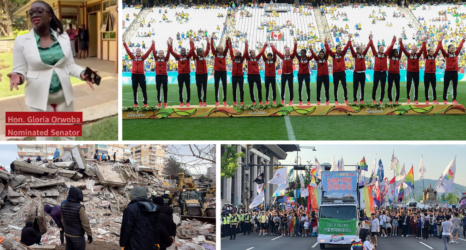We said their names each year in my Toronto schools on December 6. It was ritualistic, saying out loud the names of the 14 women murdered on Dec. 6, 1989, rolling the French r’s and picturing their faces the afternoon they were killed at École Polytechnique in Montreal. We did it to remind ourselves that gun violence does happen in Canada, that violence against women does happen in our peacekeeping nation, and that on that freezing cold, horrifying day in 1989, 14 women lost their lives because one man felt threatened by their success.
These are their names:
Geneviève Bergeron, Helene Colgan, Nathalie Croteau, Barbara Daigneault, Anne-Marie Edward, Maud Haviernick, Barbara Klucznik-Widajewicz, Maryse Laganière, Maryse Leclair, Anne-Marie Lemay, Sonia Pelletier, Michèle Richard, Annie St-Arneault, Annie Turcotte.
Twenty-five years ago, Marc Lepine, a young man who sought to attend École Polytechnique, but was twice rejected, arrived at the school with a gun in his hand and a mission to assassinate. He entered an engineering classroom, separated the men from the women, then shot the women after telling them: “You’re women, you’re going to be engineers. You’re all a bunch of feminists. I hate feminists.”
The incident would forever be known as the Montreal Massacre, and December 6 declared a National Day of Remembrance and Action on Violence Against Women. Students across Canada would henceforth spend that day each year saying the women’s names and remembering. And violence against women would forever be a part, if even just a small part, of the discourse in Canadian society.
I was only 2 years old when the shooting took place, so by the time I was in kindergarten school officials already had a couple years of memorial practice under their belts. Every year was different: Sometimes the assemblies were artistic, featuring poets, dancers or singers sharing work inspired by the lost women or by the issue of violence against women. Some years a survivor, or family member of one of the dead, might speak at a school assembly, choking back tears and describing the impact of the killing.
But no matter the program, we always said their names, because it was the women who mattered—not Lepine and his “difficult” childhood or the psychological issues that might have led to his misogynistic crime. There are still tributes online to the victims, yearly public vigils held in their honor, music recorded to preserve their memories and, of course, those school assemblies every Canadian child attends. Although I was too young to experience it, I imagine that the Canadian media’s response to the tragedy back in 1989—if it was anything like the balanced, careful coverage of the recent shooting on Parliament Hill—probably focused more on gender-based violence than on what society could have done for the mentally ill murderer before his deadly rampage.
That’s why, when I came to the U.S., I was surprised to see how the media treats similar tragedies. American film critic Roger Ebert was right when, the day after the Columbine massacre in 1999, he was asked to comment to NBC Nightly News on the link between mass shootings and violent movies, and instead put the blame on the newsmakers to whom he was speaking:
Events like this, if they are influenced by anything, are influenced by news programs like your own. When an unbalanced kid walks into a school and starts shooting, it becomes a major media event. Cable news drops ordinary programming and goes around the clock with it. The story is assigned a logo and a theme song; these two kids [at Columbine] were packaged as the Trench Coat Mafia. The message is clear to other disturbed kids around the country: If I shoot up my school, I can be famous. The TV will talk about nothing else but me. Experts will try to figure out what I was thinking. The kids and teachers at school will see they shouldn’t have messed with me. I’ll go out in a blaze of glory.
Now, images of the killer go viral, creating instant infamy, and sometimes, appallingly, turning the killer into a hero. While we might see the media trot out a survivor or the family member of one of those lost, we certainly don’t see victims remembered and memorialized year after year in schools across the nation.
The good news is that, like the White Ribbon Campaign in Canada—created in the wake of the Montreal Massacre to end gender-based violence—many of those affected by mass shootings in the U.S. have founded groups such as Sandy Hook Promise and Project IV Love to combat gun violence and create memorials honoring victims. (Project IV Love, as an example, is gathering donations to build a set of six sculptures in memory of those lost in the May 2014 shooting in Isla Vista, California.) It’s a start, and an important one.
Perhaps annual vigils are next. I know I’m grateful for all those school assemblies I had to attend, and I know how much they shaped me. I remember feeling heavy on those afternoons, loaded down with the 14 women’s names and the art their loss inspired. But I also felt fired up. Even after I graduated high school, I sought out a memorial every year, craving the heaviness of memory and needing it to motivate my desire for change.
I’m grateful, too, that in Canada we don’t forget. That we say their names. That it’s not Lepine who has stuck with us, but those bright, gone-too-soon engineers whose brilliance was taken from us.
Once again this year, I’ll be saying the names of the 14 women killed in Montreal. Will you join me?
Photo courtesy of Flickr user Chris Hibbs licensed under Creative Commons 2.0





